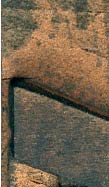|
|
||||||||||||||||||||
| introduction articles/lectures style and design functions of type usability interaction composition webstyles conclusion bibliography links |
Textual communication is of great importance for transferring knowledge and information. Clear visual design can enhance the communication of the content. In a wide range of media –and especially on the Internet– text is used to communicate on various levels. The current definitions of typography are all limited to print media and therefore undermine the Internet as a typographic medium. The Internet started as a textual medium. Without text to communicate, the Internet probably couldn't exist. Users find relevant information by using search engines, which require textual input. Other ways include searching by topic to retrieve the information. It is impossible to create an efficient navigation or a search engine for retrieving holistic knowledge without the use of text. However, it is possible to make a fully effective interface with only typography without using any other graphical means. The complex structures and different types of interactivity create new visual possibilities and functions of type. What are these new possibilities and what consequences do they have for typographic design? Why is extensive knowledge of typography essential for good web design? In the next chapter the importance of finding a balance between style and design. |
 |
||||||||||||||||||
 |
1 will-harris.com 2001, Harris. Related info: Thoughtype the importance of typography ( open in a new window) |
|||||||||||||||||||
© Copyright 2001 - 2005, Directiondesign - Jurriaan Schalken (info@directiondesign.nl)